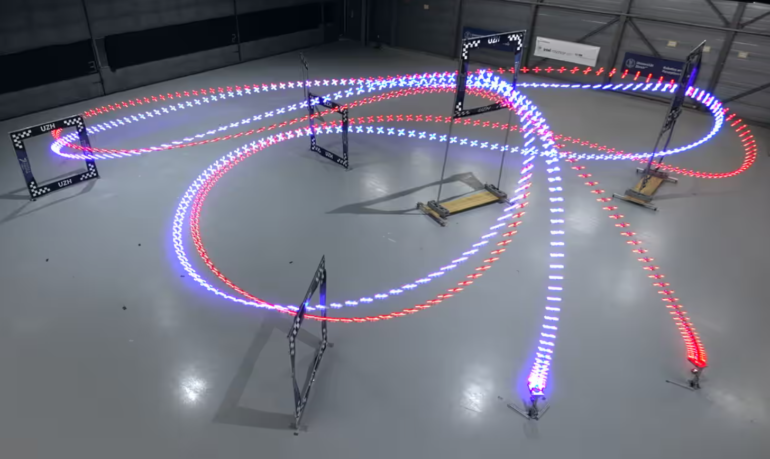TL;DR:
- AI-driven drone outperforms world champion human pilots in drone racing.
- Swift AI, developed by University of Zurich researchers, wins 15 out of 25 races.
- Algorithm learns to navigate a 3D race course at high speeds without crashing.
- Swift AI uses deep reinforcement learning to optimize racing commands.
- Neural networks process live video feeds and sensor data for precise control.
- Swift AI excels in starts and turns, with a fastest lap of 17.47 seconds.
- AI is sensitive to environmental changes like lighting and crashes occasionally.
- Human pilots express a mix of awe and unease about AI competition.
- Swift AI’s adaptability holds promise for applications beyond sports.
- Military interest in AI-powered drones, but implications debated.
Main AI News:
In a remarkable display of technological prowess, artificial intelligence (AI) has once again showcased its superiority, this time in the field of sports. Long renowned for its victories in strategic mind games like chess, Go and complex virtual realms like StarCraft and Gran Turismo, AI has now solidified its supremacy by outmaneuvering world champion human pilots in a real-world sporting spectacle.
The recent humbling of human expertise came in the form of drone racing, an electrifying sport where pilots navigate their remote-controlled aircraft at breakneck speeds through intricate 3D racecourses. The victor? An algorithm christened Swift AI was painstakingly developed by researchers at the esteemed University of Zurich. Swift AI managed to secure victory in 15 out of 25 races against world-renowned drone racing champions, proving its mettle as it navigated the challenging courses at speeds touching 50mph (80km/h), enduring accelerations akin to 5g – a force potent enough to induce blackouts in most individuals.
Elia Kaufmann, a pivotal figure in the development of Swift AI, expressed, “Our achievement signifies an unprecedented milestone – the moment a robot, driven by AI, triumphed over a human champion in a genuine physical sport that has been tailored for and nurtured by human talent.”
The battleground in this instance was a dynamic drone racing track adorned with strategically positioned gates, through which the drones had to expertly navigate to avoid catastrophic crashes. Pilots were afforded a first-person view via live feeds from onboard cameras mounted on their racing drones, thus demanding the perfect fusion of manual skill and hand-eye coordination.
Kaufmann and his accomplished colleagues elaborated on their groundbreaking achievement in an article published in the prestigious journal Nature. They chronicled a riveting series of face-offs between Swift AI and three reigning drone racing champions: Thomas Bitmatta, Marvin Schäpper, and Alex Vanover. The three pilots had a week of intense practice on the course before the competition, while Swift AI honed its abilities within a simulated environment, meticulously replicating the racing circuit.
Swift AI harnessed the prowess of deep reinforcement learning, a technique that enabled it to masterfully orchestrate the drone’s trajectory around the circuit. This approach, reliant on iterative experimentation, witnessed the drone endure hundreds of crashes during its simulated training. Remarkably, these crashes proved inconsequential as the virtual environment allowed for instantaneous restarts.
In the heat of competition, Swift AI harnessed the prowess of neural networks to process live video feeds from the drone’s onboard camera. These networks, in concert with inputs from an inertial sensor, accurately gauged the drone’s position, orientation, and velocity. Subsequently, a secondary neural network meticulously deciphered the optimal commands to propel the drone forward.
Analysis of the races uncovered Swift AI’s consistent edge at the race’s inception, demonstrating sharper turns and quicker accelerations than its human counterparts. The swiftest lap registered by Swift AI clocked in at a staggering 17.47 seconds, a mere half-second quicker than the best human pilot. However, Swift AI was far from invincible, succumbing to defeat in 40% of the races and enduring several crashes. Intriguingly, the drone exhibited sensitivity to external factors such as variations in lighting.
The aftermath left the world champions grappling with mixed emotions. Bitmatta encapsulated the sentiment, saying, “This heralds the dawn of a transformative era. Yet, as a racer, the notion of being outpaced is disconcerting.” Schäpper concurred, “Racing against a machine evokes a distinct sensation, for the machine knows no fatigue.”
Swift AI’s groundbreaking achievement extends beyond the sporting realm. Notably, it adeptly handles real-world challenges like aerodynamic turbulence, camera distortion, and shifts in illumination – obstacles that can confound traditional systems reliant on predetermined trajectories. Kaufmann envisions a broader application of this approach, foreseeing scenarios where drones undertake search-and-rescue missions in blazing infernos or conduct comprehensive inspections of colossal structures such as ships.
Despite the fervent interest of the military in AI-powered drones, skepticism regarding immediate military applications persists. Dr. Elliot Winter, a prominent figure in international law, cautioned against overestimating the seamless integration of such advancements into military drones or autonomous weapon systems. Alan Winfield, an authority in robot ethics, speculated on AI’s military potential, suggesting the technology might find utility in drone formations trailing manned aircraft.
In response, Kaufmann expressed reservations, noting, “The vast majority of drones find utility in expansive battlegrounds, employed primarily for reconnaissance or against stationary and slow-moving targets.”
Conclusion:
The triumph of Swift AI over world-class human drone racing champions underscores AI’s growing dominance in real-world sporting scenarios. This achievement showcases the potential for AI to not only redefine competition but also highlight its adaptability in handling complex challenges. This technological leap opens avenues for AI’s broader applications, promising enhanced decision-making and performance optimization in diverse sectors. As AI’s prowess continues to expand, industries should anticipate transformative shifts that demand agility and innovation to stay competitive.

